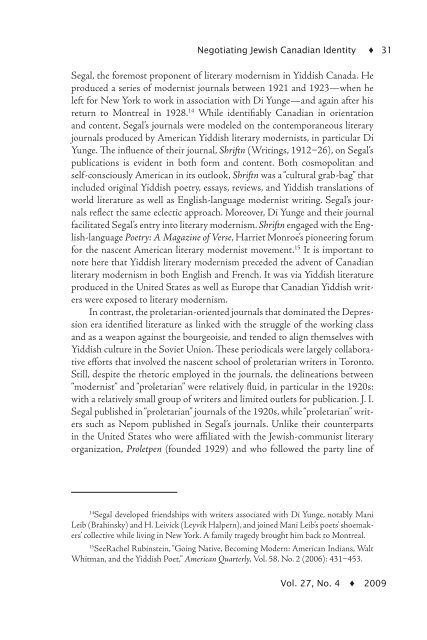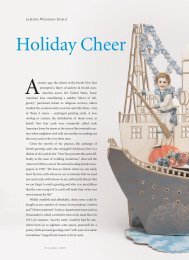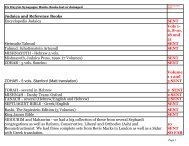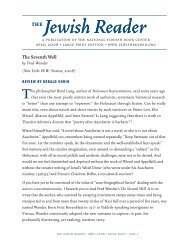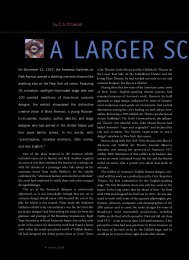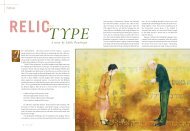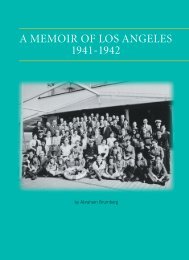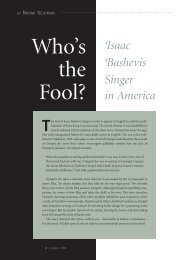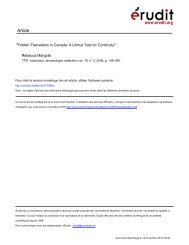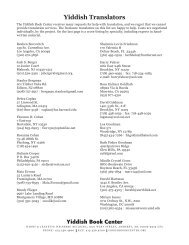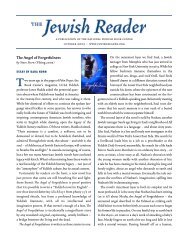Negotiating Jewish Canadian Identity Montreal Yiddish Literary ...
Negotiating Jewish Canadian Identity Montreal Yiddish Literary ...
Negotiating Jewish Canadian Identity Montreal Yiddish Literary ...
You also want an ePaper? Increase the reach of your titles
YUMPU automatically turns print PDFs into web optimized ePapers that Google loves.
<strong>Negotiating</strong> <strong>Jewish</strong> <strong>Canadian</strong> <strong>Identity</strong> ♦ 31Segal, the foremost proponent of literary modernism in <strong>Yiddish</strong> Canada. Heproduced a series of modernist journals between 1921 and 1923—when heleft for New York to work in association with Di Yunge—and again after hisreturn to <strong>Montreal</strong> in 1928. 14 While identifiably <strong>Canadian</strong> in orientationand content, Segal’s journals were modeled on the contemporaneous literaryjournals produced by American <strong>Yiddish</strong> literary modernists, in particular DiYunge. The influence of their journal, Shriftn (Writings, 1912–26), on Segal’spublications is evident in both form and content. Both cosmopolitan andself-consciously American in its outlook, Shriftn was a “cultural grab-bag” thatincluded original <strong>Yiddish</strong> poetry, essays, reviews, and <strong>Yiddish</strong> translations ofworld literature as well as English-language modernist writing. Segal’s journalsreflect the same eclectic approach. Moreover, Di Yunge and their journalfacilitated Segal’s entry into literary modernism. Shriftn engaged with the English-languagePoetry: A Magazine of Verse, Harriet Monroe’s pioneering forumfor the nascent American literary modernist movement. 15 It is important tonote here that <strong>Yiddish</strong> literary modernism preceded the advent of <strong>Canadian</strong>literary modernism in both English and French. It was via <strong>Yiddish</strong> literatureproduced in the United States as well as Europe that <strong>Canadian</strong> <strong>Yiddish</strong> writerswere exposed to literary modernism.In contrast, the proletarian-oriented journals that dominated the Depressionera identified literature as linked with the struggle of the working classand as a weapon against the bourgeoisie, and tended to align themselves with<strong>Yiddish</strong> culture in the Soviet Union. These periodicals were largely collaborativeefforts that involved the nascent school of proletarian writers in Toronto.Still, despite the rhetoric employed in the journals, the delineations between“modernist” and “proletarian” were relatively fluid, in particular in the 1920s:with a relatively small group of writers and limited outlets for publication. J. I.Segal published in “proletarian” journals of the 1920s, while “proletarian” writerssuch as Nepom published in Segal’s journals. Unlike their counterpartsin the United States who were affiliated with the <strong>Jewish</strong>-communist literaryorganization, Proletpen (founded 1929) and who followed the party line of14Segal developed friendships with writers associated with Di Yunge, notably ManiLeib (Brahinsky) and H. Leivick (Leyvik Halpern), and joined Mani Leib’s poets’ shoemakers’collective while living in New York. A family tragedy brought him back to <strong>Montreal</strong>.15SeeRachel Rubinstein, “Going Native, Becoming Modern: American Indians, WaltWhitman, and the <strong>Yiddish</strong> Poet,” American Quarterly, Vol. 58, No. 2 (2006): 431–453.Vol. 27, No. 4 ♦ 2009


